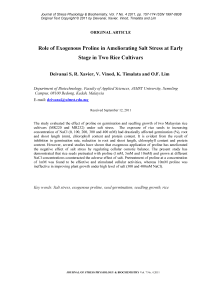Role of exogenous proline in ameliorating salt stress at early stage in two rice cultivars
Автор: Deivanai S, Xavier R., Vinod V, Timalata K, Lim O.F.
Журнал: Журнал стресс-физиологии и биохимии @jspb
Статья в выпуске: 4 т.7, 2011 года.
Бесплатный доступ
The study evaluated the effect of proline on germination and seedling growth of two Malaysian rice cultivars (MR220 and MR232) under salt stress. The exposure of rice seeds to increasing concentration of NaCl (0, 100, 200, 300 and 400 mM) had drastically affected germination (%), root and shoot length (mm), chlorophyll content and protein content. It is evident from the result of inhibition in germination rate, reduction in root and shoot length, chlorophyll content and protein content. However, several studies have shown that exogenous application of proline has ameliorated the negative effect of salt stress by regulating cellular osmotic balance. The present study has demonstrated that rice seeds pretreated with proline (1mM, 5mM and 10mM) and grown at different NaCl concentrations counteracted the adverse effect of salt. Pretreatment of proline at a concentration of 1mM was found to be effective and stimulated cellular activities, whereas 10mM proline was ineffective in improving plant growth under high level of salt (300 and 400mM NaCl).
Salt stress, exogenous proline, seed germination, seedling growth, rice
Короткий адрес: https://sciup.org/14323548
IDR: 14323548
Текст научной статьи Role of exogenous proline in ameliorating salt stress at early stage in two rice cultivars
Plants are exposed to several abiotic stresses during its growth and development. Among the abiotic stresses, salt stress drastically affects crop growth and poses a major threat to agricultural productivity worldwide (Epstein et al., 1980; Munns, 2002; Flowers, 2004). In most crop species, stress usually inhibits seed germination, seedling growth and vigor, flowering and fruit set (Zeinali et al., 2002; Sairam and Tyagi, 2004). In general, high level of salt in soil causes imbalance in osmotic potential; ionic equilibrium and nutrient uptake (Niu et al., 1995; Munns, 2002). Further, it facilitates severe ion toxicity by depositing high concentration of Na+ which causes membrane disorganization, inhibition of cell division and expansion. In addition, it also impairs a wide range of cellular metabolism including photosynthesis, protein synthesis and lipid metabolism (Alia-Mohanty and
Saradhi, 1992; Ashraf, 1994; Zhu, 2001; Parida and Das, 2005; Lichtenthaler et al ., 2005).
Plants have been classified as salt sensitive (glycophytes) and salt tolerant (halophytes) based on their ability to grow on salinity. Glycophytes employ different strategies to respond and adapt to stress. One of the prime responses to salinity stress is that it restricts plant water uptake efficiency and limits water potential (Chaum et al., 2004). An imbalance in osmotic potential would result in loss of turgidity, cell degradation and consequently cell death (Cicek and Cakirlar, 2008). However, to prevent water loss from the cell and to sustain cellular functions, plants synthesis and accumulate a number of compatible solutes called “osmolytes”. These osmolytes include proteins, carbohydrates, amino acids and quaternary ammonium compounds (Rontein et al ., 2002; Ashraf, 2004; Ashraf and Harris, 2004). It is assumed that under stress condition, these osmolytes protect the subcellular structure either by regulating cellular osmotic potential or by scavenging reactive oxygen species (ROS). ROS are highly reactive and can seriously disrupt normal metabolism of the plant through oxidation of membrane lipids, proteins and nucleic acids (Noctor and Foyer, 1998; Hernadez et al 2001; Arafa et al ., 2009).
Several strategies have been proposed to alleviate the degree of cellular damage caused by abiotic stress and to improve crop salt tolerance. Among them, exogenous application of compatible osmolytes such as proline, glycinebetaine, trehalose, etc., had gained considerable attention in mitigating the effect of salt stress (Ashraf and Foolad, 2007). Under stress condition, exogenous proline application improved tolerance of somatic embryos of celery (Saranga et al., 1992) and tobacco cell culture (Okuma et al., 2000). Further, foliar spray of proline counteracted the growth inhibition induced by NaCl in rape seed (Makela, et al., 2002), rice (Rahman et al., 2006), wheat (Raza et al., 2006) and maize (Ali et al., 2007). Studies have shown that exogenous proline application effectively regulates osmotic potential and plays a vital role in sustaining plant growth under osmotic stress (Serraj and Sinclair, 2002; Ali et al., 2007; Ashraf and Foolad, 2007; Hoque et al., 2007).
Rice is highly sensitive to salinity and its tolerance varies with growth stages. For example, seed germination and seedling growth stages are very sensitive to abiotic stress. It is opinioned that selection of plants at early stages, viz., either at germination or at seedling stage would improve the tolerance by establishing good crop strand (Munns 2002; Cuartero et al ., 2006). However, the information pertaining to the role of exogenous proline on germination and early seedling growth is limited. Hence the present study was initiated to examine the effect of exogenous application of proline on germination and seedling growth of rice under salinity stress.
MATERIALS AND METHODS
Seeds of two Malaysian rice cultivars MR220 and MR232 were surface sterilized in 2% sodium hypochlorite solution for 10 min. The seeds were placed in Petri dishes, each Petri dish consists of 50 seeds. The experiment was conducted in two subsets. In one set, the rice seeds were allowed to germinate in different concentration of NaCl (0, 100, 200, 30 and 400mM). In the other set, the seeds were pretreated in three levels of proline (1, 5 and 10mM) for 12 h and transferred to Petri dishes containing 0-400mM range of NaCl. All the seeds were allowed to grow for 10 days at 25 ± 2oC temperature. The observations were recoded on the parameters such as roots and shoot length, chlorophyll content, proline and protein content for the following treatment to study the influence of proline pretreatment in mitigating salinity stress in rice.
-
• Control
-
• NaCl concentration (0, 100, 200, 30 and
400mM).
-
• NaCl concentration + 1mM proline
-
• NaCl concentration + 5mM proline
-
• NaCl concentration + 10mM proline
Plant growth measurement
Germination percentage was recoded for the two set of experimentation on 5th day after planting. Seedlings were harvested on the 10th day and their roots and shoot length were measured and recorded.
Chlorophyll content
Total chlorophyll, chlorophyll a and chlorophyll b were determined for control, NaCl treated and pretreated proline seeds grown under salinity by following the method described by Harbone (1984). Fresh leaves (250mg) were homogenized in 80% acetone at 4oC. The extract was centrifuged at 10,000x g for 5 min. Absorbance of the supernatant was read at 646nm and 663nm using a spectrophotometer. The amount of chlorophyll in the leaf tissue was expressed as mg/g FW.
Estimation of free proline content
Free proline content of control, NaCl treated and pretreated proline seedlings were determined by following the method of Bates et al ., (1973). Leaf samples of 0.5g were used for proline extraction. Optical density of the sample extract was determined spectrophotometrically at 520nm. The concentration of proline was expressed as µmol g/ FW using a standard curve of pure proline.
Estimation of soluble protein content
Total soluble protein was determined by following the method of Bradford (1976) for the two sets of experiment along with the control. Fresh plant material of 0.5g was homogenized in 5ml of extraction buffer (50mM Tris-HCl; pH-8, 1mM PMSF, 10% (v/v) glycerol) and centrifuged. Aliquot of the extract was used for determining protein concentration using bovine serum albumin (BSA) as a standard. SDS-PAGE was performed according to Laemmli (1970) and the gels were stained with 0.03% Coomassie Brilliant Blue.
Data analysis
The experiments were performed in completely randomized design with three replicates. Differences among the treatment as well as between the cultivars were tested using the SPSS software program (Version13.0). Data were subjected to Levene's Test to test the equality of error variances. The test has shown that the error variance of dependent variables is equal across the group. Hence analysis of variances of all the parameters was performed and differences at p < 0.05 were considered significant.
RESULTS
Rate of seed germination
The onset of germination was strongly affected by increasing concentration of salt (Table-1). Reduction in the rate of germination was found to be increasing with increasing salt concentrations, particularly at 300mM and 400mM NaCl respectively, compared to control (Fig.1a). Differential response of cultivar to salinity was observed at higher level (400mM) where the rate of seed germination was poor and accounted for 9.5% in MR 220 while 43.17% in MR232.
(1mM) was more effective in ameliorating salt stress compared to 5mM and 100mM. The germination response of cultivar under salt stress is presented in Fig.1d. In both cultivars, applica- tion of minimal dose of proline (1mm) overcome the drastic effect of stress and improved the rate of germination, even at 300mM and 400mM level of salt concentrations.
Table 1 Effect of exogenous proline application on germinated rice seedlings grown under different concentrations of NaCl. The table shows the mean sum of square, F ratio and p value (< 0.05) of the determinants exposed to NaCl and exogenous proline application. The figure corresponds to mean sum of squares (MSS), F ratio and p value (≤ 0.05)
|
Effect |
Germination % |
Root length (mm) |
Shoot length (mm) |
Total chlorophyll content (mg/g FW) |
Proline content (µmol g/FW) |
Protein content |
|
NaCl (MSS) |
7813.959 |
4210.337 |
321.881 |
8.665 |
35.900 |
0.241 |
|
F ratio |
6.991* |
6.057* |
0.776* |
7.557* |
32.131* |
1.740* |
|
Sig (0.05) |
0.004 |
0.007 |
0.561 |
0.003 |
0.000 |
0.206 |
|
Proline |
2180.730 |
7185.198 |
3327.465 |
2.201 |
0.296 |
0.281 |
|
F ratio |
1.951* |
10.337* |
8.026* |
1.920* |
0.265 |
2.029* |
|
Sig (0.05) |
0.175 |
0.001 |
0.003 |
0.180 |
0.849 |
0.164 |
|
NaCl x Proline |
1117.714 |
695.077 |
414.586 |
1.147 |
1.117 |
0.138 |
|
F ratio |
31.300* |
23.811* |
14.813* |
2.104* |
6.092* |
2.581* |
|
Sig (0.05) |
0.000 |
0.000 |
0.000 |
0.026 |
0.000 |
0.006 |
Plant growth measurementRoot length
Shoot length
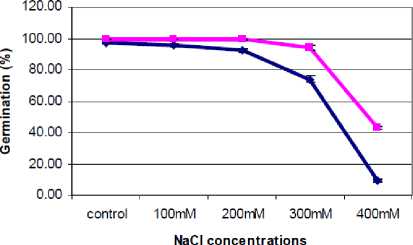
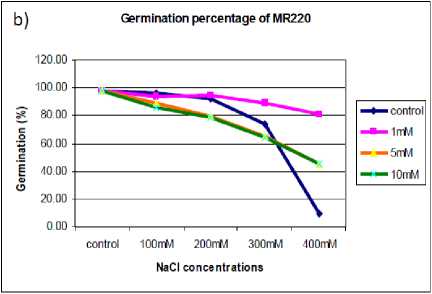
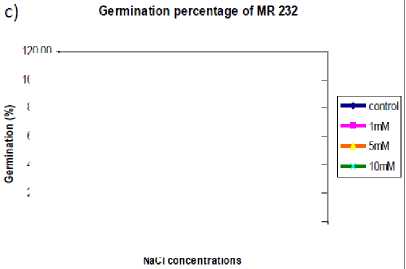
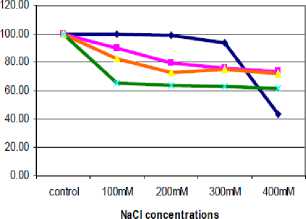
Effect of proline pretreatmen on germination
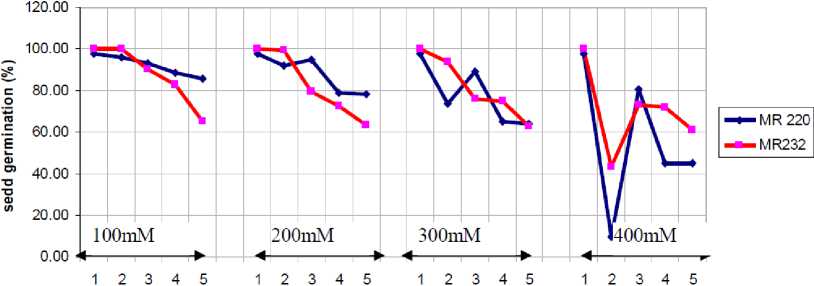
NaCI concentrations and proline pretreatment
Figure 1 a) Effect of salinity on germination of two rice cultivars. b) Influence of proline pretreatment on germination in MR 220 and c) MR 232. d) Mitigating effect of exogenous proline on rate of germination of two rice cultivars grown under different salt concentration. (n=5)
Chlorophyll content
significant reduction in photosynthetic rate in both cultivars. Both the cultivars have shown a reduction of 93%, 84%, 26% and 7% of total chlorophyll content in 400mM, 300mM, 200mM and 100mm sodium chloride treated seedlings respectively. Chlorophyll content of both the cultivars reduced significantly by increased concentration of salt (Table-1). Though there was a slight difference among the cultivars response towards exogenous proline application, the pigment content in both the varieties increased (Fig.4d), when the seeds are pretreated with 1mM of proline.
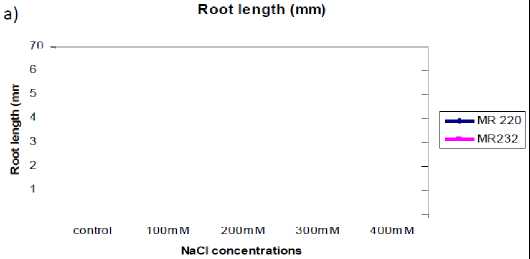
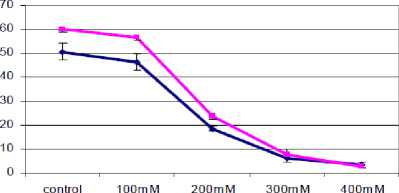
Root
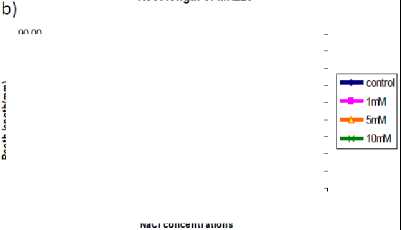
of MR220
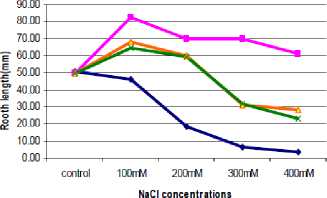
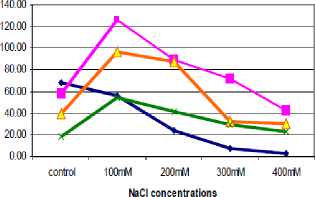
Root length of MR232
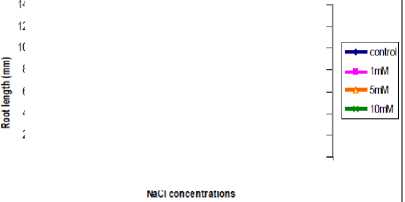
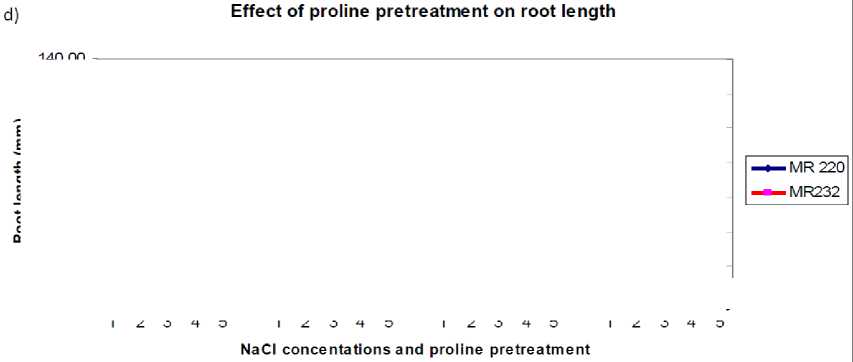
Figure 2 a) Effect of salinity on root length of two rice cultivars. b) Influence of proline pretreatment on root length in MR 220 and c) MR 232. d) Mitigating effect of exogenous proline on root length of two rice cultivars grown under different salt concentration. (n=5)
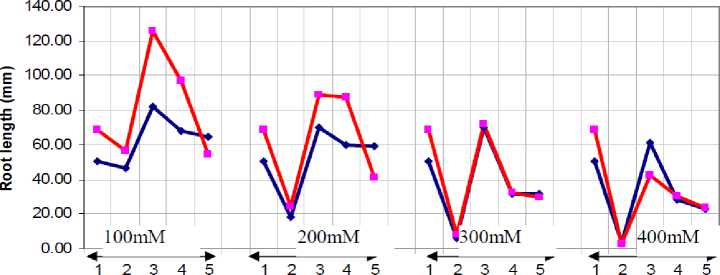
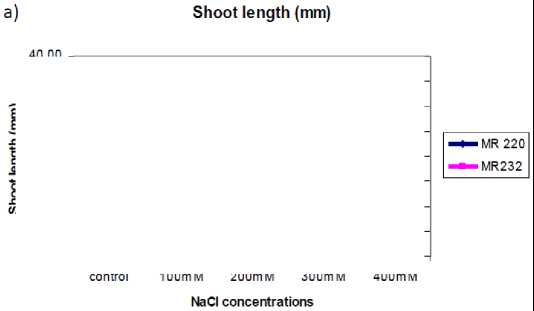
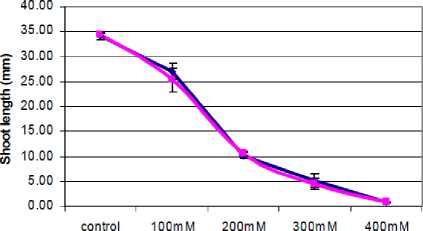

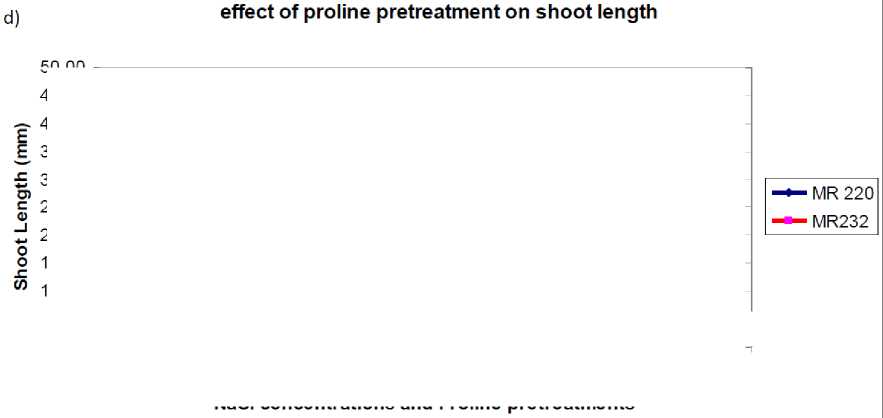
Figure 3 a) Effect of salinity on shoot length of two rice cultivars. b) Influence of proline
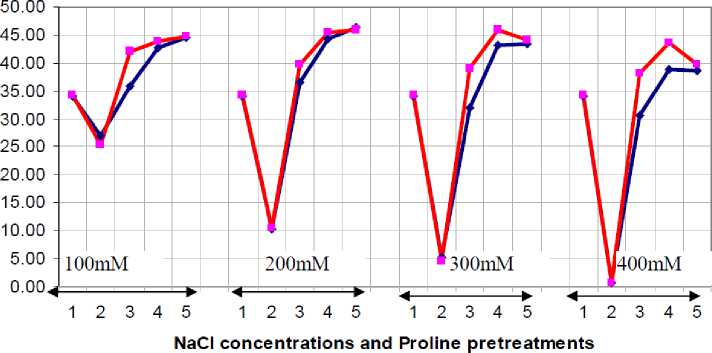
pretreatment on shoot length in MR 220 and c) MR 232. d) Mitigating effect of exogenous proline on shoot length of two rice cultivars grown under different salt concentration. (n=5)
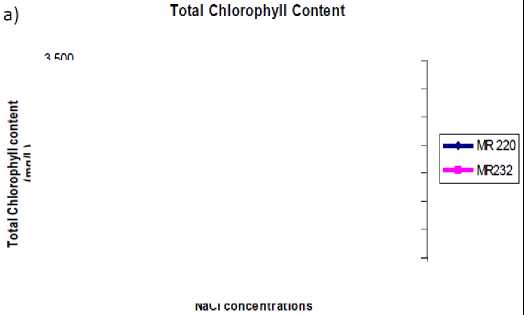
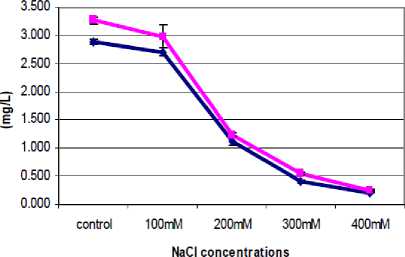
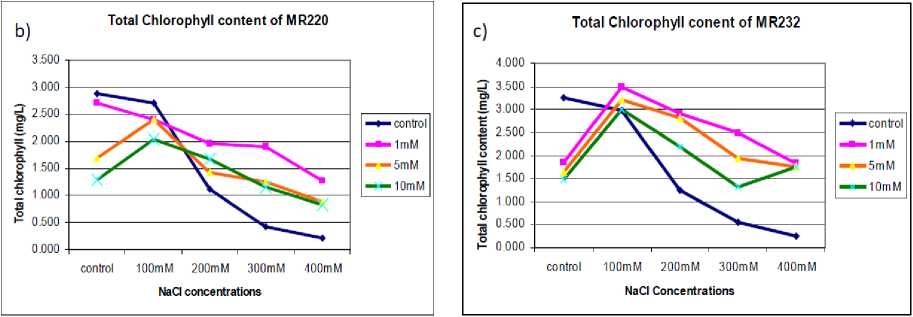
d) Effect of proline pretreatment on total chlorophyll content
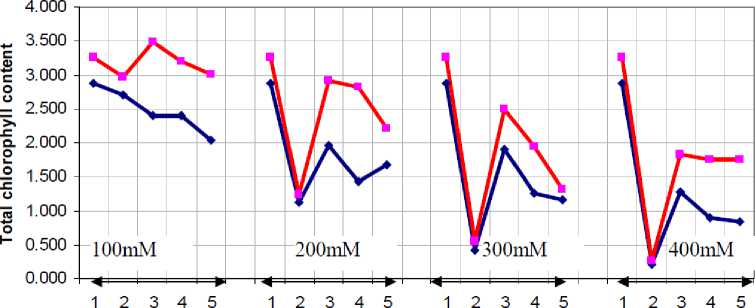
NaCI concentrationsand proline pretreatment
Figure 4 a) Effect of salinity on total chlorophyll content of two rice cultivars. b) Influence of proline pretreatment on total chlorophyll content in MR 220 and c) MR 232. d) Mitigating effect of exogenous proline on total chlorophyll content of two rice cultivars grown under different salt concentration. (n=5)
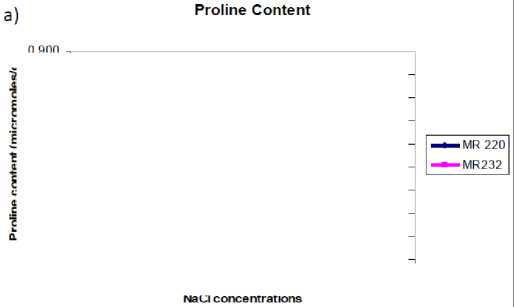
с)
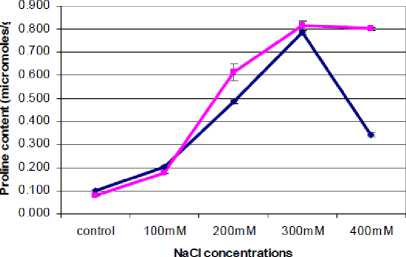
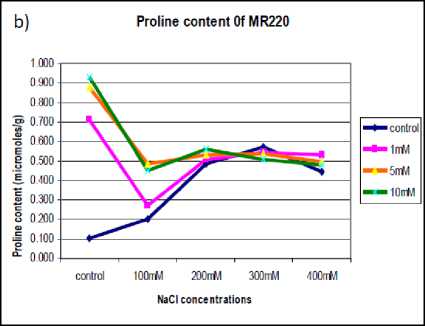
E
Proline content of MR232
E
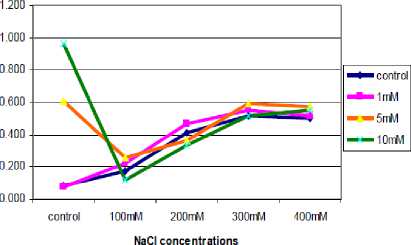
d)
Effect of proline pretreatment on proline biosynthesis
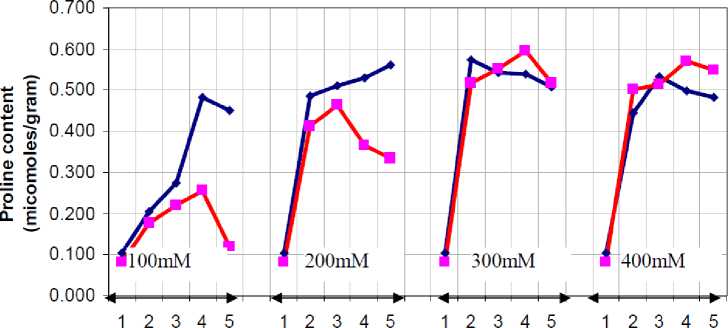
—•- MR 220
-■- MR 232
NaCI concentrations and proline pretreatment
Figure 5 a) Effect of salinity on proline biosynthesis of two rice cultivars. b) Influence of proline pretreatment on proline biosynthesis in MR 220 and c) MR 232. d) Mitigating effect of exogenous proline on proline biosynthesis of two rice cultivars grown under different salt concentration. (n=5)

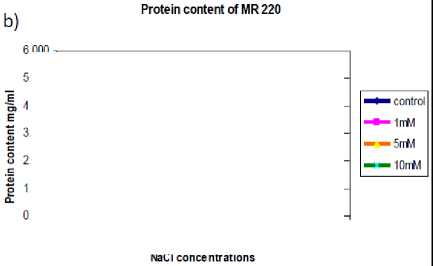
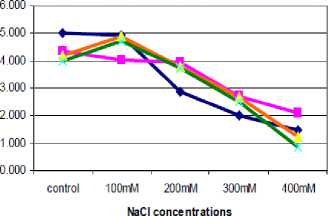
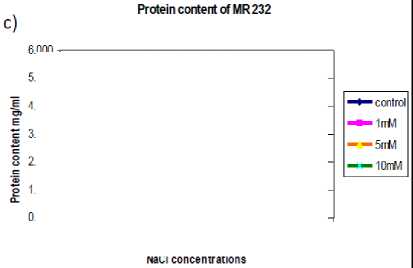
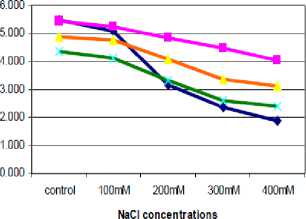
Effect of proline pretreatment on protein content
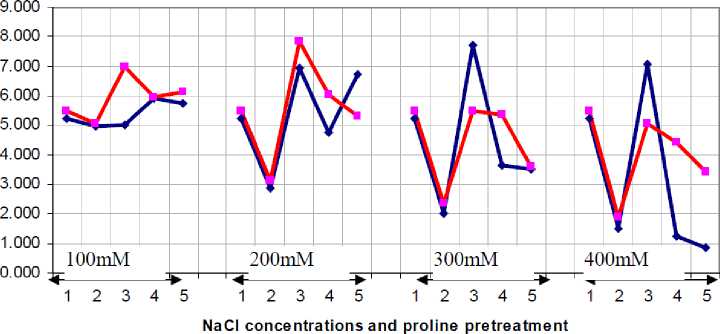
Figure 6 a) Effect of salinity on protein content of two rice cultivars. b) Influence of proline pretreatment on protein content in MR 220 and c) MR 232. d) Mitigating effect of exogenous proline on protein content of two rice cultivars grown under different salt concentration. (n=5)
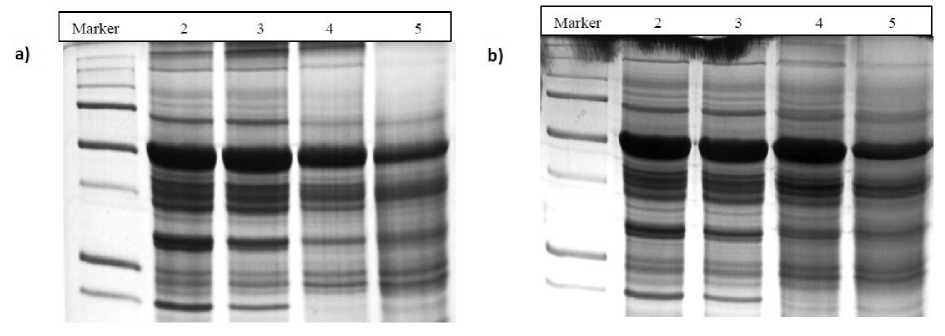
Figure 7 (a & b): SDS PAGE profile indicating the changes in protein expression of two rice cultivars
a) MR220 and b) MR 232 under different level of NaCl concentrations. Lane 1: molecular marker (Precision plus protein # 161-0373), Lane 2: 100mM NaCl, Lane 3: 200mM NaCl, Lane 4: 300mM NaCl and Lane 5: 400mM NaCl.
Proline biosynthesis
Protein content
The effect of salt stress on protein content depends on the concentration of NaCl. Increase in concentration of salt in the growing medium generally caused a decrease in protein content of the leaf in both the cultivars (Fig. 5a). The SDS –PAGE analysis revealed a considerable difference in the protein pattern under different level of salt concentration (Fig.7).
Exogenous application of different levels of proline caused significant reduction in the protein content of the leaf tissues (Table-1) and the effect was more obvious in MR232 (Fig 5b & c). The exogenous proline application improved the protein content in leaf tissues; especially lower dose level (1mM) is found to be effective for maintaining plant function at higher level of salinity stress (Fig. 5d).
DISSUSSION
Rice is very sensitive to salinity during seed germination and it impairs seedling emergence and establishment. The onset of seed germination was delayed and germination percentage was decreased due to increasing levels of salt concentration. Further the study has shown that inhibition of germination rate varied greatly with increased salinity. Germination of seeds was better in lower concentration of salinity than at higher levels (300mM and 400mM NaCl). Increasing salinity has either delayed or reduced the rate of germination (Greenway and Munns, 1980). Inhibition of germination is due to imbalance in water uptake which limits the hydrolysis of food reserves and immobilizes the translocation of food reserve from storage tissue to developing embryo axis (De larcerda et al ., 2003). Moreover, increasing salinity decreases osmotic potential and often accumulates with toxic ions which may retards seed germination
(Dodd and Donovan, 1999; Okcu et al ., 2005). It has been shown that exogenous application of proline mitigates the adverse effect of salinity by detoxifying the ions and protects the plant cells by maintaining osmotic balance (Ashraf and Foolad, 2007; Hoque et al ., 2007; Okuma et al., 2000; 2004). In the present study the seeds pretreated with proline provided significant evidence for assessing salt tolerance at germination stage.
Most investigations have shown that rice crop respond highly to salinity during early stages of growth as compared to germination. The imposition of salinity had an inhibitory effect on the root and shoot growth of rice seedling and its effect differed significantly between rice cultivars. The result indicated a decline in seedling growth as concentration of salinity increased. However exogenous application of proline at 1mM counteracted the adverse effect of mild salt stress (100mM NaCl) and manifested an increase in root length compared to control. The present finding is agreement with earlier reports that the exogenous application of proline alleviates the adverse effect of stress on plant growth (Kavi Kishore et al., 1995; Hoque et al., 2007). In addition, Mussig et al (2003) suggested that exogenous application of proline might function both as promotive as well as inhibitory on root growth. The present investigation revealed that at higher concentration proline did not ameliorate the adverse effects of salinity. The result obtained with increase level of proline on salinity was in confirmation with the findings of Qayyum et al (2007). Further, Lin (2001) indicated that the inhibitory effect of root growth may be attributed to greater accumulation of proline which may interfere with osmotic adjustment. According to Amzalleg (2002) the effectiveness of proline on the growth of salt stressed plants depends on the type of plant species, growth stage, concentration of osmoprotectant and mode of application.
Reduced plant growth is a common phenomenon when grown under increased salinity and usually expressed as stunted shoots. It is due to the fact that Na+ and Cl- sequestered in the vacuole could decrease the internal osmotic potential and cause partial dehydration of cytoplasm. Such dehydration impairs the cellular metabolism and ultimately reduced the growth of the seedlings (Le Rudulier, 2005). Further, earlier reports have shown that under moderate salt stress, cell division is unaffected and it is indicated by initiation of leaf rather than the cell elongation. The observed increase in shoot length could be attributed to positive effect of exogenous proline application which stimulated cell elongation and division (Fig.). The physiological effect of this amino acid on cell elongation was supported by Ozdemir et al ., (2004) under salt stress in rice.
Measurements of chlorophyll content provided quantitative information about photosynthesis. The reduction in growth observed in the present investigation subjected to excess salinity is often associated with a decrease in rate of photosynthetic capacity. Earlier studies have (Flexas et al., 2004, 2007) opinioned that it might be due to decreased CO2 diffusion in the leaf tissues which limits stomatal opening and alter the leaf photochemistry. Further, Munns et al., (1995) suggested that accumulation of Na+ in the vacuoles affects net photosynthesis and limit the supply of carbohydrate in the growing cells thereby inhibits the growth. Reduction in chlorophyll pigment due to stress was also reported on crops such as maize, wheat, canola, etc., (Ali et al., 2007). However pretreatment of rice seeds with proline at 1mM considerably enhanced the photosynthetic pigments under salinity stress. Increase in total chlorophyll content due to exogenous proline application primarily increased the rate of CO2 diffusion and favored higher photosynthetic rate (Ali et al., 2007; Sharkey et al., 2007)
Proline content significantly increased in rice seedlings exposed to increased salt stress. It was shown that proline accumulates in larger amount than any other amino acids and regulates osmotic potential of the cell (Ali et al ., 1999; Abraham et al ., 2003). It is also hypothesized that proline, besides being an osmolyte is also involved in scavenging free radicals and protects plant cell against adverse effect of salt by maintaining osmotic balance (Okuma et al., 2004; Ashraf and Foolad, 2007). It is obvious from the study that salt stress up-regulated the enzymes involved in biosynthesis and elevated the levels of proline and it is in accordance with the findings of Hare et al ., 1999; Chen et al ., 2000 and Munns, 2005. It has also shown that salt tolerant strains generally exhibit higher proline content than the salt sensitive (Shereen et al ., 2007). To verify whether exogenous proline modifies the internal amino acid content, proline content of leaf tissue was determined. Different concentration of proline applied exogenously increased the measurement under saline stress, suggesting that accumulation of compatible solutes often forms a basic strategy for the protection and survival of plants under stress (Hanson and Hitz, 1982).
Increasing of NaCl substantially decreased proteins content in leaves and the effect is more pronounced at 300 and 400 mM NaCl. The decrease synthesis of proteins in leaves tissues might be due to change in amino acid metabolism due to salinity stress. Further it limits the supply of CO2 and impairs the photosynthetic apparatus. Down regulation of protein synthesis is the common phenomenon under stress and it is clearly reflected in protein profiling analysis. Exogenous application of proline at 1mM improves the protein content in leaf tissues at higher level of salt. It is suggested that proline pretreatment can cause alteration in cytoplasmic viscosity of the cell
CONCLUSION
The result presented above indicated that salt stress at higher concentration, especially 300400mM NaCl is toxic to germinating seeds of both rice cultivars and resulted in reduced emergence of rice seeds. Further, it is also evident that higher concentration of salt decreased root and shoot growth and impair physiology of cells. In addition to morphological features, pigment content, proline and protein biosynthesis were also adversely affected by increased salt concentration. Exogenous proline significantly interacted with different levels of salinity, thereby mitigates detrimental effect of salt on growth and photosynthetic ability of two rice cultivars. Though proline pretreated at lower dose (1mM) improved cellular functions, it is found to be toxic and impair various functions if added at high concentration.
ACKNOWLEDGEMENTS
The authors would like to thank Ms Thulasyammal Ramiah Pillai, Faculty of Engineering and Technology, AIMST University for analyzing the data statistically and for the valuable suggestions to improve the manuscript.
Список литературы Role of exogenous proline in ameliorating salt stress at early stage in two rice cultivars
- Abraham, E., Rigo, G., Szekely, G., Nagy, R., Konez, C. and Szabados, L. (2003). Light dependent induction of proline biosynthesis by abscisic acid and salt stress is inhibited by brassinosteriods in Arabidopsis. Plant Mol. Biol. 51: 363-372.
- Alia-Mohanty, P. and Saradhi, P.P. (1992). Effect of sodium chloride on primary photochemical activities in cotyledonary leaves of Brassica juncia. Biochem Physiol. 188: 1-12.
- Ali, G., Srivastava, P.S. and Iqbal, M. (1999). Proline accumulation, protein pattern and photosynthesis in regenerants grown under NaCl stress. Biol. Plant. 42: 89-95.
- Ali, Q., Ashraf, M. and Athar, H.R. (2007). Exogenously applied proline at different growth stages enhances growth of two maize cultivars grown under water deficit conditions. Pak. J. Bot. 39(4): 1133-1144.
- Amzallag, G.N. (2002). The adaptive potential of plant development: evidence from the response to salinity. In: Lauchli, A., Luttage, U. (Eds.), Salinity: Environment-Plant-Molecules, Kluwer, The Netherlands, 291-312.
- Arafa, A.A., Khafagy, M.A. and El Banna, M.F. (2009). The effect of glycinebetaine or ascorbic acid on grain germination and leaf structure of shorghum plants grown under salinity stress. Australian J. of Crop Sci. 3(5) 297-304.
- Ashraf, M. (1994). Organic substances responsible for salt tolerance in Eruca sativa. Biol. Plant 36: 255-259.
- Ashraf, M. (2004). Some important physiological selection criteria for salt tolerance. Flora, 199: 361-376.
- Ashraf. M. and Foolad, M.R. (2007). Roles of glycinebetaine and proline in improving plant abiotic stress tolerance. Environ. Expt. Bot. 59: 206-216.
- Ashraf, M. and Harris, P.J.C. (2004). Potential Biochemical Indicators of salinity tolerance in palnts. Plant Sci. 166: 3-16.
- Bates, L.S. (1973). Rapid determination of free proline for water stress studies. Plant and Soil 39, 205-207.
- Bradford, M.M. (1976). A rapid and sensitive for the quantification of microgram quantities of protein utilizing the principle of protein-dye binding. Analytical Biochemistry, 72, 248-254.
- Cicek, N.and Cakirlar, H. (2008). Effect of salt stress on some physiological and photosynthetic parameters at three different temperatures in six soyabean (Glycine max L. Merr.) cultivars. J. of Agronomy and Crop Sci. 194: 34-46.
- Chaum, S., Kirdmanee, C. and Supaibulwatane, K. (2004). Biochemical and physiological responses of Thai Jasmine rice (Oryza sativa L.Ssp. indica cv KDML 105) to salt stress. Sci. Asia. 30: 247-253.
- Chen, W.P., Li, P.H. and Chen, T.H.H. (2000). Glycinebetaine increases chilling tolerance and reduces chilling induced lipid peroxidation in Zea mays. Plant Cell Environ. 23: 609-18.
- Cuartero, J., Bolarin, M.C., Asins, M.J. and Moreno, V. (2006). Increasing salt tolerance in the tomato. J.Expt. Bot. 57 (5): 1045-1058.
- De Lacerda, C.F., Cambraia, J., Oliva, M.A., Ruiz, H.A. and Tarquino Prisco, J. (2003). Solute accumulation and distribution during shoot leaf development in two sorghum genotypes under salt stress. Environ and Expt. Bot. 49: 107-120.
- Dodd, G.L. and Donovan, L.A. (1999). Water potential and ionic effects on germination and seedling growth of two cold desert shrubs. American J Botany. 86: 1146-1153.
- Epstein. E., Norlyn, J.D., Rush, D.W. and Kingsbury, R.W. (1980). Saline culture of crops: A genetic approach. Science. 210: 339-404.
- Flexas J., Bota J., Loreto F., Cornic G.and Sharkey T.D. (2004). Diffusive and metabolic limitations to photosynthesis under drought and salinity in C3 plants. Plant Biol. 6: 269-279.
- Flexas, J., Diaz Espejo A., Galmes J., Kaldenhoff R., Medrano H. and Ribas Carbo M. (2007). Rapid variations of mesophyll conductance in response to changes in CO2 concentration around leaves. Plant, Cell and Environment. 30: 1284-1298.
- Flowers, T.J. (2004). Improving crop salt tolerance. J. of Expt. Botany. 55 (396): 307-319.
- Green way H. and Munns, R. (1980). Mechanisms of salt tolerance in non halophytes. Annual Review of Plant Physiol. 31: 149-190.
- Hanson, A.D and Hitz, W.D. (1982). Metabolic response of mesophytes to plant water deficits. Annual Review of Pant Physiol. 33: 163-203.
- Hare, P.D., Cress, W.A. and Van Staden, J. (1999). Proline synthesis and degradation: a model system for elucidating stress related signal transduction. J. Exp. Bot. 50: 413-34.
- Harborne, J.B. (1984). Phytochemical Methods. A Guide to Modern Techniques of Plant Analysis. London: Chapman & Hall.
- Hernandez, J.A., Ferrer, M.A., Jimenez, A., Barcelo, A.R. and Sevilla, F. (2001). Antioxidant systems and O2/H2O2 production in the apoplast of pea leaves. Its relation with salt induced necrotic lesion in minor veins. Plant Physiol. 127: 817-831.
- Hoque, M.A., Okuma, E., Banau, M.N.A. Nakamura, Y., Shimoishi, Y. and Murata, N. (2007). Exogenous proline mitigates the detrimental effects of salt stress more than exogenous betain by increasing antioxidants enzyme activity. J.Plant Physiol. 64: 553-561.
- Kavi Kishore, P.B., Hong, G.H. Miao, C.A.A. Hu and D.P.S. Verma. (1995). Overexpression of D1-pyrroline-5-carboxlate synthetase increases proline production and confers osmotolerance in transgenic plants. Plant Physiol. 108: 1387-1394.
- Le Rudulier, D. (2005). Osmoregulation in rhizobia: The key role of compatible solutes. Grain Legume 42, 18 -19.
- Lichtenthaler, H.K., Langsdorf, G., Lenk, S. and Bushmann, C. (2005). Chlorophyll fluorescence imaging of photosynthetic activity with the flesh lamp fluorescence imaging system. Phtosynthetica. 43: 355-369.
- Lin, C.C and Kao, C.H. (2001). Cell wall peroxidase against ferulic acid, lignin and NaCl reduced root growth of rice seedlings. J. Plant Physiology. 158: 667-671.
- Makela, P., Kontturib, M., Pehua, E.and Somersaloa, S. (2002). Photosynthetic response to drought and salt stressed tomato and turnip rape plants to foliar applied glycinebetaine. Physiol. Plant. 105: 45-50.
- Munns, R. (2002). Comparative physiology of salt and water stress. Plant Cell. Environ. 25: 239-250.
- Munns, R. (2005). Genes and salt tolerance: bringing them together. New Phytol. 167: 645-63.
- Munns, R., Schachtman, D.P and Condon, A.G. (1995). The significance of two phase growth response to salinity in wheat and barley. Australian J. Plant Physiol. 22: 561-596.
- Mussig, C., Fischer, S. and Altamann, T. (2002). Brassinosteroid-regulated gene expression. Plant Physiol. 129, 1241-1251.
- Niu, X., Bressan, R.A., Hasegwa, P.M. and Pardo, J.M. (1995). Ion homeostasis in NaCl stress environments. Plant Physiol. 109: 735-742.
- Noctor, G. and Foyer, C.H. (1998). Ascorbate and glutathione: keeping active oxygen under control. Annu. Rev. Plant Physiol. Plant Mol. Biol. 49: 249-279.
- Okcu, G., Kaya, M.D. and Atak, M. (2005). Effects of salt and drought stresses on germination and seedling growth of pea (Pisum sativum L.). Turkish journal of Agriculture and forestry. 29: 237-242.
- Okuma, E., Soeda, K., Tada, M. and Murata, Y. (2000). Exogenous proline mitigates the inhibition of growth of Nicotiana tabacum culturedcell under saline conditions. Soil Sci. and Plant Nutri. 46: 257-263
- Okuma, E., Murakami, Y., Shimoishi, Y., Tada, M. and Murata, Y. (2004). Effects of exogenous application of proline and betaine on the growth of tobacco cultured cells under saline conditions. Soil and Plant Nutrition. 50: 1301-1305.
- Ozdemir, F., Bor, M., Demiral, T. and Turkan I. (2004). Effects of 24-epibrassinolide on seed germination, seedling growth, lipid peroxidation proline content and antioxidative system of rice (Oryza sativa L.) under salinity stress. Plant Growth Regulation 42, 203-211.
- Parida, A.K. and Das, A.B. (2005). Salt tolerance and salinity effects on plants: A review. Ecotoxicol. Environ. Safety, 60(3): 324-349.
- Rahman, S. Md., Miyake, H. and Takeoka, Y. (2002). Effects of exogenous glycinebetaine on growth and ultra structure of salt stressed rice seedlings (Oryza sativa L.) Plant Prod. Sci. 5: 33-44.
- Raza, S.H., Athar, H.R. and Ashraf, M. (2006). Influence of exogenously applied glycinebetaine on the photosynthetic capacity of two differently adapted wheat cultivars under salt stress. Pak. J. Bot. 38(2): 341-351.
- Rontein, D., Basset, G. and Hanson, A.D. (2002). Metabolic engineering of osmoprotectant accumulation in plants. Metabolic Engineering, 49-56.
- Sairam, R.K. and Tyagi, A. (2004). Physiology and molecular biology of salinity stress tolerance in plants. Current Sci. 86 (3): 407-421.
- Saranga, Y., Rhodes, D. and Janick, J. (1992). Changes in amino acid composition associated with tolerance to partial desiccation of celery somatic embryos. J. Amer. Soc. Hort. Sci. 117: 337-341.
- Serraj, R. and Sinclair, T.R. (2002). Osomlyte accumulation:can it really help increase crop yield under drought conditions? Plant Cell Environ. 25: 333-341.
- Sharkey, T.D., Carl, J.B., Graham, D.F. and Singsaas, E.L. (2007). Fitting photosynthetic carbon dioxide response curves for C3 leaves. Plant Cell Environ. 30: 1035-1040.
- Shereen, A., Ansari, R.U., Yamin, S., Raza, S., Mumtaz, S., Khan, M.A. and Mujtaba, S.M. (2007). Physiological responses of rice (Oryza sativa L.) to saline stress. Pak. J. Bot., 39: 2527-2534.
- Qayyum, B., Shahbaz, M. and Akram, N.A. (2007). Effect of 24-epibrassinolide on salt tolerance of wheat. International Journal of Agriculture and Biology 9, 584-589.
- Zeinali, E., Soltani, A. and Galeshi, S. (2002). Response of germination component to salinity stress in oilseed rape (Brassica napus L.). Iranian J. of Agric. Sci. 33: 137-145.
- Zhu, J.K. (2001). Plant salt tolerance. Trends in Plant Sci. 6: 66-71.

